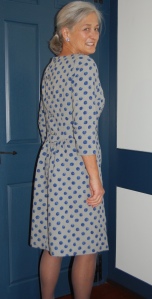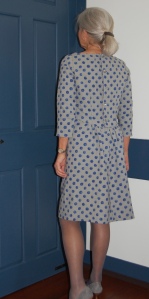Dresses – and garments in general – with back interest have always intrigued me. The addition of a simple back belt can add so much to a coat design, for example, and a yoke in the back of a dress can be the perfect place to add complimentary buttons which might not have a place on the front of the dress. Perhaps it was this reason why I was drawn to this Advance pattern, which I found in an Etsy store.

Thanks to one of my readers, I know that this pattern dates to 1960.
I hesitated for quite a while before buying it, as I just wasn’t so sure the gathered back skirt on this dress would look as good on me as it looked on the pattern envelope. I also did not want a “dated” or “too cutesy” look. But finally I gave in and made the purchase. The buttoned back and the dropped back waist were two details which really appealed to me, as well as the sleek sheath look of the front of the dress. I also knew that the right fabric could work wonders, and I bought the pattern with this gray and blue polka dotted wool/silk blend in mind.

I purchased this fabric from Mendel Goldberg in New York City.
Then, there is always that steadfast fall-back, as well – making a muslin (toile) and if it really doesn’t work, then just scrapping it! What could I lose besides a few yards of cheap muslin and a few hours of time?
I had never used an Advance vintage pattern before, so I was interested to see how one would make up. I was impressed! The pattern pieces went together very precisely, and, in particular, the flounce, or gathering, at the back of the skirt was not overdone. The only initial change I made to the pattern before cutting out my muslin was to lower the bust dart, which I always have to do. Once I made the muslin, it was a little snug across the front, so I added ¼” to either side seam. As it turned out, I needed the extra width just across the midriff area, and ended up taking out quite a bit of extra width from the waist down.
While I was working on the muslin, I was in a quandary over the buttons. I had to have them before I could start work on the fashion fabric because of those pesky, but beautiful, bound buttonholes, which are one of the first things to go in. Nothing I had on hand was right and after a very brief dalliance with the thought of blue buttons (what was I thinking, even briefly??), I knew gray mother-of-pearl buttons were what was needed. As luck would have it I found a set of six 5/8” buttons in an Etsy shop, which were described as blue-gray mother-of-pearl. As soon as they arrived in my mailbox, I knew they were perfect.
By this time I had transposed the muslin onto white silk organza, made my working pattern, basted the fashion fabric and the organza together, and ordered marine blue crepe de chine from EmmaOneSock for the lining.

For those of you who asked, here is a picture of the silk organza being used as the pattern. When cut out, the two are basted together by hand along the seam lines, dart markings, and hem lines and then handled as one piece.

Here the facings are turned towards the inside. Proper measuring is essential for this technique to be successful.
Although the pattern called for lining only the skirt back, I wanted to fully line the entire dress. The pattern for the back skirt lining is shown here in the thumbnail diagram:
It was cut narrower than the skirt back, with darts for shaping rather than gathering. I had to make a decision about how to complete the lining – should I attach it to the waist seam at the back and somehow join the front to the back at the side seams, or should I make the lining as a completely free-falling piece? I opted for the latter, with the sleeves, of course, being inserted separately. It worked beautifully. Then, for some extra detail, I added a contrasting flat piping to the edge where the lining meets the facing.

Often facings are eliminated in couture sewing, but in this case, with the buttoned placket in the back, I decided to keep the facings so the buttonholes and buttons would have a firmer foundation.
This dress turned out to be all that I wanted – a classic slim sheath from the front, with surprise back detail which (I think?) is flattering, adding extreme comfort to its wearing, and which sets it apart from the average design.
Coming and going, it feels like a good way to start off the new sewing year .

















Diversionary Tactics
While bogged down in the fitting of these wool slacks, my mind has been thinking about capes instead.
I know myself well enough to recognize it is always prudent to work on the least favorable item first and save the ”goodies” for later, and that is what I have done with this cape and slacks ensemble introduced in my last post. There is a reason I have made few pairs of slacks in my years of sewing: I find fitting them tedious. So, while I think I am just about satisfied with how they are coming along, the thing which has kept me sane is the prospect of making that beautiful cape.
All of this has led me to do a little research into capes. I started with Fairchild’s Dictionary of Fashion, as I often do when investigating a sewing/fashion topic. Well, oh my! There happen to be no fewer than 8 pages of entries for capes, cloaks, and shawls! It turns out a cape is not just a cape, and the history of capes is long indeed. For my purposes here, the simple definition of a cape is sufficient: “Sleeveless outerwear of various lengths usually opening in center front; cut in a full circle, in a segment of a circle, or on the straight – usually with slits for arms. A classic type of outerwear worn in one form or another throughout history….” (The Fairchild Dictionary of Fashion, Third Edition, by Charlotte Mankey Calasibetta and Phyllis Tortora, Fairchild Publications, Inc., New York, New York, c2003)
Interestingly, Christian Dior has no entry for capes in his Little Dictionary of Fashion, another one of my go-to reference books. But as luck would have it, the newest J. Peterman Company catalogue, Owners Manual No. 197, Holidays 2021, arrived in my mailbox this week. And there on page 5, he has offered for sale a Plaid Wool Cape, with the enticing caption: “Capes are mysterious. Alluring. Functional. In the past, they’ve existed as an alternative to coats so you wouldn’t crush your real clothing…” He goes on to say one will not want to take off this particular cape, as there could be nothing better under it. Well, I guess that’s an arguable point, but you get the picture. Capes demand attention, but in a good way.
I started thinking about the patterns I have gathered over the years, and I remembered at least two which feature capes. Once I got into my pattern collection, I found four besides the one I am currently using.
The earliest one is clearly this Vogue Couturier Design from the second half of the 1950s.
Its description reads: “Suit and Reversible Cape. Easy fitting jacket with concealed side pockets buttons below shaped collar. Below elbow length sleeves. Slim skirt joined to shaped waistband. Reversible, collarless cape has arm openings in side front seams.” I think this is pretty spectacular, and while the suit is lovely, it is enhanced many times over by the addition of the short cape.
Next is this Advance pattern from the 1960s, a cape in two lengths.
I was attracted to this pattern because of its lengthwise darts, its rolled collar and back neckline darts.
The 1970s is represented by the Molyneux pattern I am using and two more: a Pucci design and a Sybil Connolly design.
I purchased the Pucci pattern for the dress (which I now believe to be too “youthful” for me), but its cape certainly completes the outfit. The description reads: “…Cape with jewel neckline has arm openings in side front seams; back vent [which I find interesting}. Top-stitch trim.”
And the final cape pattern I own – almost a capelet – is this Sybil Connolly design. The caption states “…Short asymmetrical flared cape has side button closing.” No arm slits in this cape.
I actually made this cape a number of years ago, but I must admit I have worn it infrequently. The wide stance of the neckline makes it a little unstable. I guess there is a good reason most capes have a tighter neckline – and open in the center front.
So there is my whirlwind cape tour. What do you think? Are capes alluring and mysterious? Functional and sophisticated? I, for one, think capes have a slightly romantic charm to them. Do you?
17 Comments
Filed under Advance vintage patterns, Capes, Fashion commentary, Mid-Century style, Uncategorized, vintage Vogue Designer patterns, vintage Vogue patterns from the 1950s, vintage Vogue patterns from the 1970s
Tagged as capes, fashion sewing, vintage fashion, vintage Vogue patterns